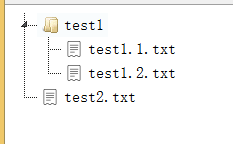jstree中json data 的生成
jstree中json data 的生成
jstree官网上给出的json数据格式是这样的:
- <span style="font-size:14px;">// Alternative format of the node (id & parent are required)
- {
- id : "string" // required
- parent : "string" // required
- text : "string" // node text
- icon : "string" // string for custom
- state : {
- opened : boolean // is the node open
- checked: boolean // is the node checked
- disabled : boolean // is the node disabled
- selected : boolean // is the node selected
- },
- li_attr : {} // attributes for the generated LI node
- a_attr : {} // attributes for the generated A node
- }</span>
如果我想要把一个文件夹及它里面的文件用jstree显示,怎么办呢?总不能自己再按上边的格式一个一个写吧。好了,这里就涉及到一个问题,怎么样把一个路径转化成json data.
举个例子:我在E盘下有一个test文件夹,我想要把test文件夹下的所有文件用jstree目录树显示。这时候jstree的数据源就应该是test文件夹的 json数据。
test文件夹下的目录结构如下图:

test文件目录它的json格式应该是这样的:
- [{"attributes":{"id":"0"},"parent":"0","state":{"opened":false},"text":"test1" ,"children":[{"attributes":{"id":"1"},"parent":"0","state":{"opened":true},"text":"test1.1.txt" , "type":"leaf" },{"attributes":{"id":"2"},"parent":"0","state":{"opened":true},"text":"test1.2.txt" , "type":"leaf" }] },{"attributes":{"id":"3"},"parent":"0","state":{"opened":true},"text":"test2.txt" , "type":"leaf" }]
上面的json格式中:
attributes:{id: }是每个节点的id.
parent:是这个节点的父节点的id
state:{opened:false} 表示的是这个节点的状态是不打开
children[]:表示的是这个节点的子节点。
如何把一个目录的路径,转化为上面的json格式呢?我们要用无限递归遍历这个目录,把相应信息提取出来,转化为json格式的字符串。
下面给出实现的代码:用Java写的:
- /**
- * 给定任意的路径 ,无限递归获得该路径下的所有节点,并转化为json串 ,把该json串存到root.json文件中, 用作jstree的数据源
- * @param f parent
- * 路径名 父节点ID
- * @return str,然后将str写入文件中。
- * @author YanniZhang
- * @date 2015.4.17
- */
- package test;
- import java.io.File;
- import java.io.FileWriter;
- import java.io.BufferedWriter;
- import java.io.IOException;
- public class test {
- public static int parentId=0;
- public static String str="";
- public static void main(String[] args) {
- File f =new File("E:/test1");//给定的路径是E盘下的test文件夹。这里换成你想要转换成json串的任意路径
- String str="[";
- // 从根开始 ,调用ToJson()方法,把路径转化成json串。结果是str
- str+=ToJson(f,0);
- str += "]";
- /**
- * 把json串写入文件root.json中
- *
- */
- try {
- File file = new File("E:/root.json");
- // if file doesn't exists, then create it
- if (!file.exists()) {
- file.createNewFile();
- }
- FileWriter fw = new FileWriter(file.getAbsoluteFile());
- BufferedWriter bw = new BufferedWriter(fw);
- bw.write(str);
- bw.close();
- } catch (IOException e) {
- e.printStackTrace();
- }
- }
- /*ToJson()方法,实现把指定路径转化为json串。采用无限递归遍历路径下的所有节点的方法实现*/
- private static String ToJson(File f,int parent) {
- //杳出顶层的子节点
- File[] files = f.listFiles();
- //遍历它的子节点
- for(int i=0; i<files.length; i++)
- {
- //有子节点
- if(files[i].isDirectory())
- {
- str+= "{\"attributes\":{\"id\":\"" +parentId
- + "\"},\"parent\":\"" + parent
- + "\",\"state\":{\"opened\":false},\"text\":\"" + files[i].getName() + "\" ,";
- str += "\"children\":[";
- parent=parentId;
- parentId++;
- //遍历它的子节点
- File[] list=files[i].listFiles();
- for(int j=0;j<list.length;j++)
- {
- if(list[j].isDirectory())
- {
- //还有子节点(递归调用)
- str+= "{\"attributes\":{\"id\":\"" +parentId
- + "\"},\"parent\":\"" + parent
- + "\",\"state\":{\"opened\":false},\"text\":\"" + list[j].getName() + "\" ,";
- str += "\"children\":[";
- parent=parentId;
- parentId++;
- ToJson(list[j],parent);
- str+="]";
- str+=" }";
- if(j<list.length-1)
- {
- str+=",";
- }
- }
- else
- {
- str += "{\"attributes\":{\"id\":\"" + parentId
- + "\"},\"parent\":\"" + parent
- + "\",\"state\":{\"opened\":true},\"text\":\"" + list[j].getName()
- + "\" " + ", \"type\":\"leaf\" }";
- parentId++;
- if (j < list.length - 1)
- {
- str += ",";
- }
- }
- }
- str+="]";
- str+=" }";
- if(i<files.length-1)
- {
- str+=",";
- }
- }
- else
- {
- str += "{\"attributes\":{\"id\":\"" + parentId
- + "\"},\"parent\":\"" + parent
- + "\",\"state\":{\"opened\":true},\"text\":\"" + files[i].getName()
- + "\" " + ", \"type\":\"leaf\" }";
- parentId++;
- if (i < files.length - 1)
- {
- str += ",";
- }
- }
- }
- return str;
- }
- }
得到的json数据存在E:/root.json
得到了任意一个路径的json 数据后。我们就要用这个json数据 生成目录树了。
如何利用上面生成的json数据请看下一篇博文:“jstree获得节点的相对路径”。

